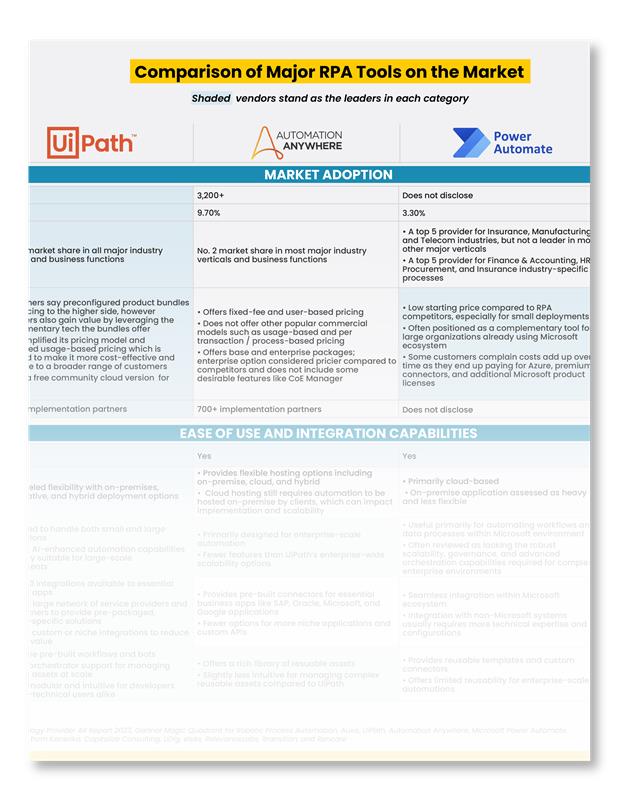In today’s competitive landscape, operational efficiency is not just a goal; it’s a requirement. Yet, many organizations are still relying on manual processes for core back office functions, creating a significant drag on productivity and scalability.
Every manual keystroke introduces the risk of costly errors, slows down cycle times, and prevents your most skilled employees from focusing on strategic work. This outdated way of operating is no longer a sustainable model for growth.
That is why business leaders are turning to Robotic Process Automation (RPA) as a foundational tool for building a more efficient and resilient operation.
What is robotic process automation?
Robotic Process Automation is software that mimics the way people interact with computers to complete repetitive, rules-based tasks. Think of it as a “digital worker” that never gets tired or makes a mistake. You can develop an RPA bot how to move information between systems, process forms, or generate reports.
Once it’s deployed it performs those steps quickly, consistently, and around the clock. Unlike traditional automation, which often requires custom integrations or coding, RPA works directly with your existing applications by clicking, typing, and navigating screens just like a person would.
The best part? You don’t need to overhaul your existing systems to use it. RPA sits on top of the tools you already have, which makes it faster and more affordable to implement than most large IT projects. It’s a simple way to eliminate your most frustrating manual tasks without disrupting the business.
In fact, 53% of businesses have already implemented RPA, according to a Deloitte global survey. That number keeps growing each year, which shows just how common these challenges are and how quickly companies are moving to solve them. If more than half of your competitors are already leveraging automation technology, the real question is: can you afford not to?
What are the benefits of RPA?
The widespread adoption of this technology comes down to one thing: it delivers real, measurable results fast. In today’s competitive environment, simply hiring more people to handle manual processes is no longer a sustainable solution. It drives costs up without fixing the root of the problem. RPA solves this by taking repetitive work off your team’s plate, creating impact in months rather than years.
The benefits start to add up quickly:
- Cost savings: You are automating tasks that would otherwise take hours of human effort, while software robots work 24/7 without a break.
- Accuracy: A bot does not have a bad day or lose focus. It performs each task with complete precision every time, which means better data quality and less time spent fixing mistakes.
- Fast ROI: Research shows that businesses often see an RPA ROI of 30% to 200% within the first year, with long-term gains sometimes reaching 300 percent. In fact, a UiPath/IDC survey found that 44% of companies using RPA reported lower costs, 41% reported revenue growth, and many saw measurable improvements in quality.
- Employee impact: Instead of being stuck with repetitive work, your people can focus on higher-value tasks. This reduces burnout, improves morale, and raises overall productivity.
RPA examples across the business
Because the need for greater efficiency is universal, practical RPA examples exist within every core business function.
- In human resources, think about employee onboarding. A bot can set up new user accounts, enroll them in payroll, and grant system access in minutes, ensuring your new hire is ready to go on day one.
- In finance, RPA can streamline the entire accounts payable process. Bots can capture invoices, match them against purchase orders, and flag discrepancies, which speeds up payments and improves accuracy.
- In customer service, bots can handle routine requests such as password resets, account updates, or order status checks, freeing agents to focus on more complex customer needs.
- IT operations is another major area. From resetting passwords to monitoring system alerts, RPA helps reduce response times and keep business-critical systems running smoothly.
The applications are practically endless, and every function stands to benefit from freeing employees from repetitive work to handle more complex tasks.
A look at the RPA Tools Landscape
Once a business decides to explore RPA, the next logical question is: how do I decide between the top RPA tools to use? While the market is full of options, a few key platforms have emerged as trusted leaders for enterprise-grade automation.
The RPA market is led by three major platforms, each with a strong reputation for delivering comprehensive capabilities:
- UiPath: Often recognized as the market leader by industry analysts, it’s known for its user-friendly interface and large developer community, making it a very accessible and scalable platform.
- Automation Anywhere: A cloud-native platform that excels in providing a web-based environment for building and managing bots.
- Blue Prism: Often favored by large, regulated industries for its top-tier security, governance, and robust scalability.
Choosing the right RPA provider
Starting with a best-in-class platform is a critical first step. It provides the powerful engine you need for transformation. However, realizing the full value of that engine depends on the expertise of the partner guiding the implementation. The magic happens when great technology is paired with deep operational experience.
Even the best platform can struggle to deliver its full potential without the right strategy. A strategic partner ensures your investment translates into measurable business outcomes. Here’s what to look for:
- A business-led approach: The biggest pitfall in automation is applying it to a broken or inefficient process. A strategic partner avoids this by starting with a deep dive into your operational challenges, ensuring the technology is the solution to the right problem and delivers a clear business impact.
- Deep platform and technical expertise: Look for a partner with certified expertise who knows the chosen RPA platform inside and out. They should be able to leverage its full capabilities—from basic automation to advanced AI features—to design the most effective and efficient solution.
- A proven track record of measurable ROI: A top-tier partner is focused on delivering tangible business outcomes, whether it’s reduced costs, increased capacity, or improved accuracy. Look for partners who can demonstrate measurable ROI with a clear and proven implementation methodology.
- 24/7 managed services and support: Automation doesn’t stop at deployment. The best partners offer ongoing maintenance to monitor your digital workforce, manage exceptions, and ensure your automations are delivering value around the clock.
RPA is just the beginning
Automating repetitive tasks is a big win, but it is only the foundation.
RPA handles the “doing.” It sets the stage for advanced technologies like Artificial Intelligence (AI) and Machine Learning (ML), which handle the “thinking.” By combining RPA with AI, your digital workers get smarter. They can process unstructured data such as emails or documents, extract key information, and recognize patterns that help streamline workflows.
This is the path to true digital transformation. Human and digital workforces working together create operations that are faster, smarter, and more resilient than ever before.
Why Auxis: Driving measurable ROI with RPA
Embarking on an automation journey requires a partner who understands your business and industry, knows how your processes work, and can advise you on how to improve and streamline them. Experience matters and so does having the right strategy.
That is what sets us apart. We do not just advise on RPA, we use it every day to run our own nearshore business process outsourcing operations. Our team brings a real-world perspective that traditional consultants often lack. We know what works in practice, not just what looks good on a slide.
Our model combines strategic consulting with a top-tier nearshore delivery team in Latin America. You get seasoned experts to design the right automation roadmap, along with skilled talent in a compatible time zone to build and manage it. The result is a practical, transparent path to realizing real value from your investment at a cost far below typical onshore models.
Discover how RPA can cut costs, boost accuracy, and free your team from repetitive work. Book a consultation with our experts to get started.
Frequently Asked Questions
Is robotic process automation only for big companies?
What is the impact of RPA on the workforce?
What's the difference between RPA and AI?


